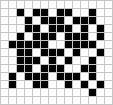Difference between revisions of "Main Page"
Jump to navigation
Jump to search
(updated DYK number) |
(added #104) |
||
| (2 intermediate revisions by the same user not shown) | |||
| Line 61: | Line 61: | ||
! <h2 style="margin:0; background:#cedff2; font-size:120%; font-weight:bold; border:1px solid #a3b0bf; text-align:left; color:#000; padding:0.2em 0.4em;">Did you know...</h2> | ! <h2 style="margin:0; background:#cedff2; font-size:120%; font-weight:bold; border:1px solid #a3b0bf; text-align:left; color:#000; padding:0.2em 0.4em;">Did you know...</h2> | ||
|- | |- | ||
|{{LifeWiki:Did you know|total= | |{{LifeWiki:Did you know|total=104|show=10}} | ||
|} | |} | ||
|} | |} | ||
Revision as of 14:37, 1 April 2020
|
| Overview · How to contribute · ConwayLife.com | Image gallery · A–Z index |
|
|
